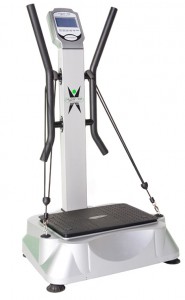Positive vibration, whole body vibration
I have been intrigued by whole body vibration (WBV) for a few years now. If you’ve caught earlier posts, you’ll recall that whole body vibration was developed in India and then passed onto the Greeks to improve overall functioning. More recently, it was used by the Russians to rehabilitate astronauts who may have lost muscle and bone mass during space missions. Now, however, it’s embraced by many sports medicine clinics and fitness facilities and gaining widespread popularity as strategy for improving leg muscle strength (and by default, balance and mobility) among adults as they age.
Positive evidence continues to accumulate in favour of WBV and in fact, researchers have conducted an extensive review of existing studies to assess whether or not WBV training can decrease the risk of falls and fractures. This is important since women as young as 35 years start to lose bone density and strength and by the time they reach the age of 50, they have a 40% risk of suffering a fracture due to osteoporosis during the rest of their lifetime. Moreover, during the first five years after menopause, women can experience as much as a 30% loss of bone density.
A bit of detail….this specific analysis included 15 studies enrolling both men and women between the ages of 64 and 82. Half of them included women only. WBV was conducted between 1 and 5 times per week over a period of 6 weeks to 18 months, and vibration was delivered during the sessions from anywhere to 15 seconds to 3 min for up to 27 times. The techniques were either vertical vibration (in which one stands on the platform and the vibration is delivered upwards), or side-alternating (in which the vibration is delivered side to side; this strategy apparently mimics a see-saw and the natural human gait.
Overall, they found that WBV may help to improve basic balance ability (i.e. sitting and standing balance) and offer significant benefit in terms of overall functional ability, especially in frailer individuals. Less clear, however, is whether or not it is effective in ultimately preventing falls; in this case, one could argue that by improving balance, WBV lowers fall and fracture risk but it isn’t so clear cut. What may actually be the case is that WBV plus an exercise program can help to do both.
So clearly, the verdict is still out on the usefulness of WBV. What’s more? The exact regimen that offers the most benefit remains unknown. Still, it’s clear that some data suggest that as we age, there are strategies other than drugs that might help to keep us walking and balanced.
As always, there is no time like the present to get moving on exercise and bone health awareness. You may be in your mid-30s and believe that nothing is going to change, but the stats are stacked against you without some sort of self-intervention.
Positive vibration? You bet!
Read More
Newsflash…Before you ‘D’ know the facts. New recommendations from EMAS.
Vitamin D. Lately it’s been touted as the cure-all for all that ails. From bone health and diabetes, to cancer and infections, vitamin D is the go-to supplement. But, do you really need it? And how much should you be taking on a daily basis?
Vitamin D levels are reportedly low in women undergoing menopause and because it is necessary to maintain bone health, there is no question that it’s in great demand by our bodies. This is especially true of fair skinned individuals, women, and people who live at higher altitudes. In fact, research shows that a number of factors can influence how the body synthesizes or produces Vitamin D, including altitude, time of year (e.g. winter) time of day, amount of exposed skin at any given time, skin pigmentation, extensive use of sun protection (i.e. sunscreen, protective clothing, shade) and air pollution). However, the more news that comes out about vitamin D, the more confusion abounds as to its true benefits and how much you should be taking.
Some of that much needed detail is provided in a recent statement issued by the European Menopause and Andropause Society. Rather that put you to sleep with all the details, here a few highlights that sets current knowledge about vitamin D on the correct path:
- Although there have been a ton of studies on vitamin D, linking it to outcomes and risks and benefits in a variety of conditions, evidence for its benefit is strongest in terms of bone/skeletal health.
- Osteoporosis is very common in postmenopausal women leading to increased fracture risk. It appears that adequate levels of vitamin D may help preserve bone structure and contribute to the function of muscles. In studies, women with the lowest vitamin D blood levels were shown to have the highest fracture risk.
- Healthy postmenopausal women can insure that their body’s levels of vitamin D are optimized by exposing skin to the sun, 15 minutes at a time at least three to four times a week during Spring, Summer and Fall. This does not include artificial UV exposure from tanning booths.
- Experts recommend that women supplement sun exposure with no more than 800 to 1,000 IU of vitamin D supplements a day.
- If you are someone at risk for low vitamin D levels, you should see your doctor or health care practitioner for screening to achieve optimal vitamin D levels.
- Women who are obese, have conditions that prevent proper absorption of nutrients (for example, HIV or chronic diarrhea) or have liver or kidney issues need to have tailored vitamin D recommendations.
And the news about over supplementation and toxicity? First of all, you can never get vitamin D toxicity through sunlight (although as we know, too much sun can lead to other problems, like skin cancer). And, toxicity issues have been linked to dosages above 50,000 IU over several months time. Last, women with cancer are likely to convert vitamin D in the body faster, so need lower levels. Again, this calls for monitoring by a health practitioner.
Overall, before you ‘D.’ know the facts. These recommendations are a great start.
Read More
Wednesday Bubble: Warn me
This week’s Bubble is straight out of the buyer beware files. Introducing Warmi ‘Better Menopause Relief.’
Warmi, according to the manufacturer website, is “a unique vegetable and fruit extract supplement. It contains 85% organic ingredients in a vegetable capsule and is 100% Vegetarian.” Moreover, Warmi provides safe, natural, full spectrum menopause relief” meaning that in a single study of 122 women, Warmi “also enhanced hormonal balance, mood, cardiovascular and bone health, vaginal dryness and intercourse discomfort — even overall quality of life. Many benefits were noted in just 30 days.”
Evidently, Warmi delivers, all that and more.
How, you ask?
Warmi’s active ingredients are:
- Gluocosinates, plant chemicals that are found in cruciferous vegetables such as cabbage, which are believed to help fight cancer and possibly, promote heart health.
- Beta-sitosterol, a substance found in plants and suggested to have properties similar to cholesterol. It is used in some European countries for benign prostatic hyperplasia (enlarged prostate) and according to the Warmi website, has been shown in laboratory animals to have some sort of weak estrogen effect that “may benefit the reproductive system.”
- Hesperidin, a flavonoid found in citrus fruits which has shown promise in laboratory animals to potentially reduce blood pressure and cholesterol and work as an anti inflammatory and produce pain killing effects. The Warmi website says that it may also ‘help bone metabolism.’ Note that this claim is based on one study done in mice, which demonstrated a decline in the loss of bone density.
So, Warmi is made up of cancer and heart protective ingredients, may alleviate pain, and…helps with menopausal symptoms? But how does it work? In the FAQ section of the product website, it says that while “The exact mechanism of Warmi is not fully understood but is believed to be associated with certain estrogen receptors.”
I’m sorry…WHAT?!
All I can think of when I think ‘Warmi’ is “warn me.” Yes, warn me that medical and scientific claims without substantiation are to be questioned, that comparisons to existing alternative strategies are difficult without well-designed research, and that unpublished, unreviewed product data are just that: unpublished, unreviewed and non-vetted.
Forewarned is forearmed.
Enough said.
Read More
Plums…delicious, sweet. And, good for bone health?
[Image: all rights reserved 2012. Used with permission by Tartella. Visit them online at http://www.tartella.com/ and if you love this print as much as I do, you can purchase it in their Etsy store.]
Yowza! I am excited about study findings published in the British Journal of Nutrition linking dried plums (better known as the lowly prune) to improved bone mineral density in menopausal women. If these findings ring true and can be duplicated in larger groups of women, they may have a tremendous impact on the steps we take to preserve our bones as we age — most notably, the ability to avoid bisphosphonates — which have been linked to collapse of jaw bones and even an increase in the fractures they are supposed to protect. Moreover, although calcium supplementation is broadly recommended, there is an indication that it may increase heart disease risk in some women.
However, as one of the investigators note in BJN, study findings consistently show that greater intakes of fruits and vegetables have positive effects on bone resorption (the breakdown of bone), adding prunes among fruits and onions among vegetables, to be the most effective functional foods in terms of their actions on modulating the process by which bones break down and build up again.
In animal studies, prunes were shown to prevent bone loss as well as restore bone mineral density in conditions created to mimic bone loss associated with osteoporosis. In addition to these studies, researchers had also a conducted a short, three-month study in menopausal women in whom bone mass was improved simply by eating around 10 prunes (100 g) daily.
In this latest iteration, the same researchers compared two groups of menopausal women assigned to eat around 100 gm of prunes (~10) or 75 gm dried apples (the equivalent of the prunes in terms of energy, carbohydrates, fats and fiber) daily for a year. All of the women had been in menopause for anywhere from one to 10 years, were not on hormone therapy and were also asked to take 500 mg calcium plus 400 IU vitamin D with their daily dried fruit.
The findings? By the end of one year, women eating prunes had significantly lower levels of several markers for bone turnover compared to their peers who ate dried apple. Conversely, the prune eaters had significantly higher levels of bone mineral density in their ulnas (one of two long bones in the forearm) and spine compared to the other group. The researchers say that this is partly due to the fact that prunes suppress the rate at which bone cells break down bone, which exceeds the rate at which they build it up as we age.
Women in particular lose up to 50% of their spongy, or trabecular bone (the network that makes up most of bone structure) and up to 30% of their cortical bone (the outer shell) within the first 10 years of the onset of menopause. Of the investigators, Professor and chair of Florida State University’s Department of Nutrition, Bahram Arjmandi, suggests that women (and men) interested in maintaining or even improving bone health start eating two to three prunes a day and gradually build to six to 10. Arjmandi says to “do something meaningful and practical beforehand, ” and “don’t wait until you get a fracture or are diagnosed with osteoporosis” and need medication.
Sure, prunes get a bad rap. But aren’t ‘bad’ bones even worse? Truly, prunes can be ‘as delicious and sweet’ as plums. The writing on the wall suggests that you don’t wait until it’s too late.
Read More
Whole body vibration training: what’s the lowdown on bone health?
Back in 2009, I wrote a post about the positive effect that whole body vibration training might have on body composition. Now, researchers are suggesting that it may actually affect bone health in a beneficial way. Who would have thunk it?
If you don’t know what I’m referring to, whole body vibration training utilizes a vibration platform for a number of theoretical benefits ranging from weight loss and rehabilitation for muscles to improved balance However, it is also promoted a low-impact alternative to drugs and other therapies to counteract bone loss associated with aging. The concept itself is a bit strange; a person stands, feet shoulder length apart , knees locked and hands to their sides on a vibrating platform producing between.3g’s and 1.1g’s (28Hz-60Hz) of vibration for up to 30 minutes a day (the maximum recommended vibration exposure without adverse effects). That’s it. No cardio, no weight training, no nothing. Just a whole lotta vibration.
So, does it or doesn’t it?
According to a study in the Journal of Osteoporosis, just 20 minutes of intermittent vibration (one minute on, one minuter rest) at low frequency, low magnitude strength (i.e. 12 Hz) resulted in significant and clinically meaningful declines in a primary marker for bone resorption (when bone cells break down bone). In this study, 46 postmenopausal women received vibration once or three times weekly over eight weeks compared to sham vibration (minimal, continuous vibration) once weekly. Of note, a third had already been diagnosed with osteoporosis, osteoporotic fractures or osteopenia, and 41%, with osteoarthritis. In other words, two thirds of these women already had issues with bone health.
The findings?
For the first time, whole body vibration training was shown to benefit bone health. In fact, the primary marker for bone resorption was reduced by 34.6% in women who had vibration therapy three times a week compared to women who had the sham vibration, which researchers say is clinically meaningful. The key was training at least three times week with high frequency, low magnitude vibration whereas training only one day a week only had minimal benefit.
Importantly, this decline is also significant when compared to a 25% reduction in markers of bone resorption in women with osteoporosis/oteopenia who take medication and regularly walk.
Information is still needed on factors like the duration of vibration training, if more or less would suffice and if benefits can actually be maintained over time. It’s also unclear if gender, nutritional or hormone status or use of medications affects the value of vibration training. Still, the results are pretty encouraging.
Positive vibrations? Yeah, you bet!
Read More










